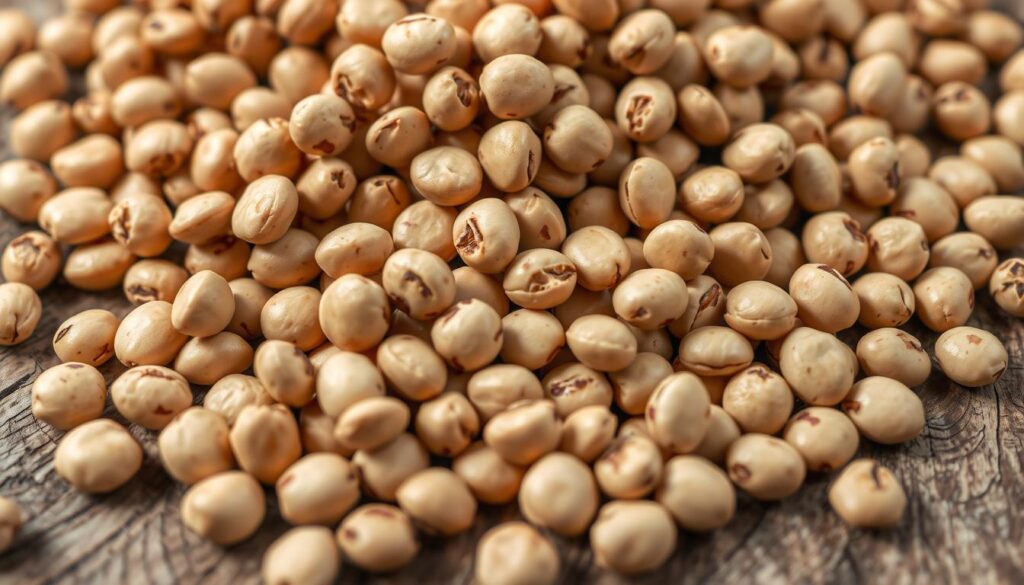Can Dogs Eat Pinto Beans? 4 Critical Facts for Every Dog Owner!
Table of Contents
Can Dogs Eat Pinto Beans?
As a dog owner, you might wonder if pinto beans are safe for your pet. Dogs can benefit from pinto beans because they are nutrient-dense. However, you must be aware of the risks. But, there are risks you need to know about.
In this guide, we’ll cover the important facts about dogs and pinto beans. We will discuss both the positive and negative aspects.
This will help you decide if pinto beans are right for your dog.
A colorful illustration of a happy dog surrounded by a variety of healthy foods, including pinto beans, fresh vegetables, and kibble, set against a vibrant park background with sunlight filtering through trees. The scene should evoke a sense of nourishment and joy in dogs enjoying a balanced diet.

Key Takeaways
- Pinto beans can be a good source of protein and fiber for dogs, but you need to watch the size and how you prepare them.
- Pinto beans have vitamins and minerals that can help your dog’s health.
- But, there are risks like digestive problems, allergies, and toxicity if not cooked right or given in the right amount.
- Always talk to your vet before adding new foods, like pinto beans, to your dog’s diet.
- It’s important to prepare pinto beans correctly and give them in the right amount to keep your dog safe.
The Nutritional Benefits of Pinto Beans for Dogs
Pinto beans are great for our furry friends. Proteins, fiber, vitamins, minerals, and antioxidants abound in them. Knowing this can help you add them to your dog’s meals.
Essential Proteins and Fiber Content
Pinto beans have lots of plant-based protein. This is good for your dog’s muscles. They also have fiber, which helps with digestion and keeps the gut healthy.
Key Vitamins and Minerals
Pinto beans have important vitamins and minerals. They have iron for oxygen transport and folate for cell growth. They also have copper, magnesium, and phosphorus for strong bones and a healthy immune system.
Antioxidant Properties
Pinto beans are full of antioxidants. These fight off harmful free radicals. Adding pinto beans to your dog’s diet can boost their health and fight off diseases.
| Nutrient | Amount per 1 cup of Cooked Pinto Beans |
|---|---|
| Protein | 15g |
| Fiber | 15g |
| Iron | 3.6mg |
| Folate | 294mcg |
| Copper | 0.5mg |
| Magnesium | 120mg |
| Phosphorus | 481mg |
“Pinto beans are a fantastic source of plant-based protein and fiber, making them a valuable addition to a dog’s diet.”
Can Dogs Eat Pinto Beans? Understanding Safety and Risks
Feeding your dog the right foods is key. Pinto beans might seem like a good choice, but there are risks to consider.
Pinto beans have a lot of fiber. This can upset your dog’s stomach, causing bloating, gas, and diarrhea. See how your dog responds by starting with tiny doses.
Some dogs might be allergic to pinto beans. This can cause skin problems or worse health issues. Watch your dog for any signs of an allergy before adding pinto beans to their diet.
Pinto beans also have toxins like lectins and phytic acid. These can harm dogs if they eat too much. Cooking the beans well can help reduce these toxins.
“The choice to give pinto beans to your dog should ultimately be discussed with your veterinarian, who can offer tailored advice based on your dog’s particular nutritional needs and health concerns.”
Knowing the risks helps you decide if can dogs have pinto beans or if are black beans good for dogs. Always talk to your vet before making changes to your dog’s diet.

A close-up view of a pile of fresh, glossy pinto beans scattered on a rustic wooden surface, showcasing their distinctive beige and brown mottled patterns, with soft natural lighting highlighting their texture and color variations.
How to Properly Prepare Pinto Beans for Your Dog
Adding pinto beans to your dog’s diet can be a great way to improve their nutrition. But, it’s important to prepare them safely. Follow these steps to make sure your dog enjoys the benefits of pinto beans without risks.
Safe Cooking Methods
Choosing the right cooking method is crucial when feeding pinto beans to your dog. Boiling or steaming is the safest way. It removes harmful compounds. Don’t fry or season the beans, as this can add toxic ingredients.
Portion Size Guidelines
Start with small portions when introducing pinto beans to your dog’s diet. A tablespoon or two per meal is a good starting point. If your dog does well, you can gradually increase the amount. Remember, pinto beans are high in fiber, and too much can upset their stomach.
Dangerous Ingredients to Avoid
- Salt: Excessive salt can be harmful to dogs, so it’s best to avoid adding any seasoning or salt to the pinto beans.
- Onions and garlic: These ingredients can be toxic to dogs and should never be added to their food.
- Spices: Many spices, such as chili powder or cumin, can irritate a dog’s digestive system and should be avoided.
By following these guidelines, you can safely add pinto beans to your dog’s meals. This will give them a nutritious boost. Always prioritize your dog’s health and safety.
Signs Your Dog May Be Sensitive to Pinto Beans
When you add pinto beans to your dog’s food, watch how they react. These legumes are good for many dogs, but some might not do well. Look out for signs that your dog might not like pinto beans.
- Gastrointestinal distress: Watch for vomiting, diarrhea, or belly pain after they eat pinto beans.
- Skin irritation: Check for rashes, hives, or itching that could be a sign of a reaction to legumes for dogs.
- Behavioral changes: If your dog seems tired, restless, or acts strangely, it might be because of the dog diet with pinto beans.
- Loss of appetite: If your dog suddenly doesn’t want to eat or loses interest in food, it could mean they don’t like pinto beans.
If you see any of these signs, stop giving your dog pinto beans right away. Talk to your vet. They can figure out why and help you safely add legumes for dogs back into their diet.
Every dog is different, and how they react to food can vary. Keep an eye on how your dog feels and adjust their dog diet as needed. This will keep them content and healthy.
Conclusion
Your dog may benefit from eating pinto beans. They offer proteins, fiber, vitamins, and minerals. But, it’s important to know the risks and prepare them right to keep your dog safe.
Consult your veterinarian before introducing new meals. Watch how your dog reacts closely.
When it comes to can dogs eat beans and pinto beans nutrition, be careful. Give pinto beans as an occasional treat, not a main food. This way, you can add these healthy legumes to your dog’s diet safely.
Your dog’s health is most important. Knowing the good and bad of pinto beans helps you make better choices. With care, you can give your dog a balanced diet with pinto beans sometimes.
FAQ
Can dogs eat pinto beans?
Yes, pinto beans can be a healthy part of a dog’s diet in small amounts. They offer proteins, fiber, vitamins, and minerals that are good for your dog. But, introduce them slowly and in small amounts to prevent digestive problems.
What are the nutritional benefits of pinto beans for dogs?
Plant-based proteins and fiber abound in pinto beans.These help with digestion and make your dog feel full. They also have vitamins like iron, folate, and magnesium, and antioxidants that boost the immune system.
Are there any safety concerns with feeding pinto beans to dogs?
Dogs can safely eat pinto beans, but there are certain hazards. Some dogs might feel uncomfortable or get gas from eating them. Make sure to remove any seasonings or harmful ingredients when cooking pinto beans for your dog.
How can I cook pinto beans for my canine companion?
Cook pinto beans well and don’t add any seasonings or sauces. Start with a little and see how your dog reacts. Keep an eye out for any indications of allergies or an upset stomach.
How do I know if my dog is sensitive to pinto beans?
Keep an eye out for symptoms such as vomiting, diarrhea, bloating, or gas. If your dog shows these symptoms after eating pinto beans, stop giving them to them. Talk to your vet to see if pinto beans are the problem and find other safe foods.

